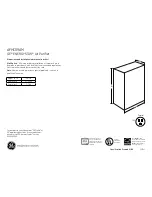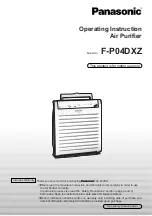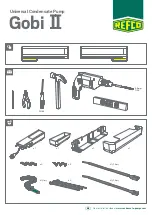
5
4. Installing the refrigerant piping
4.1. Precautions for devices that use R410A refrigerant
•
Refer to page 3 for precautions not included below on using air condition-
ers with R410A refrigerant.
•
Use ester oil, ether oil, alkylbenzene oil (small amount) as the refrigeration
oil applied to the
fl
ared sections.
•
Use C1220 copper phosphorus, for copper and copper alloy seamless
pipes, to connect the refrigerant pipes. Use refrigerant pipes with the thick-
nesses speci
fi
ed in the table to the below. Make sure the insides of the
pipes are clean and do not contain any harmful contaminants such as sul-
furic compounds, oxidants, debris, or dust.
Warning:
When installing or relocating, or servicing the outdoor unit, use only the speci-
fi
ed refrigerant (R410A) to charge the refrigerant lines. Do not mix it with any
other refrigerant and do not allow air to remain in the lines.
If air is mixed with the refrigerant, then it can be the cause of abnormal high
pressure in the refrigerant line, and may result in an explosion and other haz-
ards.
The use of any refrigerant other than that speci
fi
ed for the system will cause
mechanical failure or system malfunction or unit breakdown. In the worst
case, this could lead to a serious impediment to securing product safety.
P100-P140
Liquid pipe
ø9.52 thickness 0.8 mm
Gas pipe
ø15.88 thickness 1.0 mm
•
Do not use pipes thinner than those speci
fi
ed above.
4.2. Connecting pipes (Fig. 4-1)
•
When commercially available copper pipes are used, wrap liquid and gas pipes
with commercially available insulation materials (heat-resistant to 100°C or more,
thickness of 12 mm or more). Direct contact with the bare piping may result in
burns or frostbite.
•
Be sure to separate thermal insulation for gas and liquid refrigerant pipes.
•
The indoor parts of the drain pipe should be wrapped with polyethylene foam
insulation materials (speci
fi
c gravity of 0.03, thickness of 9 mm or more).
•
Apply thin layer of refrigerant oil to pipe and joint seating surface before tightening
fl
are nut.
A
•
Use 2 wrenches to tighten piping connections.
B
•
Use leak detector or soapy water to check for gas leaks after connections are
completed.
•
Apply refrigerating machine oil over the entire
fl
are seat surface.
C
•
Use the
fl
are nuts for the following pipe size.
D
P100-P140
Gas side
Pipe size (mm)
ø15.88
Liquid side
Pipe size (mm)
ø9.52
•
When bending the pipes, be careful not to break them. Bend radius of 100 mm to
150 mm are suf
fi
cient.
•
Make sure the pipes do not contact the compressor. Abnormal noise or vibration
may result.
1
Pipes must be connected starting from the indoor unit.
Flare nuts must be tightened with a torque wrench.
2
Flare the liquid pipes and gas pipes and apply a thin layer of refrigeration oil (Ap-
plied on site).
•
When usual pipe sealing is used, refer to Table 1 for
fl
aring of R410A refrigerant
pipes.
The size adjustment gauge can be used to con
fi
rm A measurements.
A
(Fig. 4-1)
Copper pipe O.D.
(mm)
Flare dimensions
øA dimensions (mm)
ø6.35
8.7 - 9.1
ø9.52
12.8 - 13.2
ø12.7
16.2 - 16.6
ø15.88
19.3 - 19.7
ø19.05
23.6 - 24.0
B
(Fig. 4-1)
Copper pipe O.D.
(mm)
Flare nut O.D.
(mm)
Tightening torque
(N·m)
ø6.35
17
14 - 18
ø6.35
22
34 - 42
ø9.52
22
34 - 42
ø12.7
26
49 - 61
ø12.7
29
68 - 82
ø15.88
29
68 - 82
ø15.88
36
100 - 120
ø19.05
36
100 - 120
A
Flare cutting dimensions
B
Flare nut tightening torque
A
B
C
D
A
Die
B
Copper pipe
A
B
Fig. 4-1
Fig. 4-2
A
Table 1 (Fig. 4-2)
Copper pipe O.D.
(mm)
A (mm)
Flare tool for R410A
Flare tool for R22·R407C
Clutch type
ø6.35 (1/4")
0 - 0.5
1.0 - 1.5
ø9.52 (3/8")
0 - 0.5
1.0 - 1.5
ø12.7 (1/2")
0 - 0.5
1.0 - 1.5
ø15.88 (5/8")
0 - 0.5
1.0 - 1.5
ø19.05 (3/4")
0 - 0.5
1.0 - 1.5
90°±0.5°
45°±2°
R0.4 - R0.8
øA






































